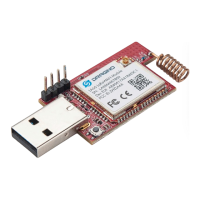User Manual for LoRaWAN End Nodes - LA66 USB LoRaWAN Adapter User Manual
Table of Contents:
• 1. LA66 USB LoRaWAN Adapter
• 1.1 Overview
• 1.2 Features
• 1.3 Specification
• 1.4 Pin Mapping & LED
• 1.5 Example: Send & Get Messages via LoRaWAN in PC
• 1.6 Example: How to join helium
• 1.7 Example: Send PC's CPU/RAM usage to TTN via python
• 1.8 Example: Send & Get Messages via LoRaWAN in RPi
• 1.9 Example: Use ofLA66 USB LoRaWAN Adapter and mobile APP
• 1.9.1 Hardware and Software Connection
•
Overview:
• Hardware Connection:
• Download and Install App:
• Use of APP:
• 1.9.2 Send data to TTNv3 and plot location info in Node-Red
• 1.10 Upgrade Firmware of LA66 USB LoRaWAN Adapter
• 2. FAQ
• 2.1 How to Compile Source Code for LA66?
• 2.2 Where to find Peer-to-Peer firmware of LA66?
• 3. Order Info
• 4. Reference
• 5. FCC Statement
1. LA66 USB LoRaWAN Adapter
1.1 Overview
LA66 USB LoRaWAN Adapter is designed to fast turn USB devices to support LoRaWAN wireless features.
It combines a CP2101 USB TTL Chip and LA66 LoRaWAN module which can easy to add LoRaWAN wireless
feature to PC / Mobile phone or an embedded device that has USB Interface.
LA66 is a ready-to-use module that includes the LoRaWAN v1.0.3 protocol. The LoRaWAN stack used in LA66
is used in more than 1 million LoRaWAN End Devices deployed world widely. This mature LoRaWAN stack greatly
reduces the risk to make stable LoRaWAN Sensors to support different LoRaWAN servers and different countries'
standards. External MCU can use AT command to call LA66 and start to transmit data via the LoRaWAN protocol.
Each LA66 module includes a world-unique OTAA key for LoRaWAN registration.
Besides the support of the LoRaWAN protocol, LA66 also supports open-source peer-to-peer LoRa Protocol for
the none-LoRaWAN application.
LA66 is equipped with TCXO crystal which ensures the module can achieve stable performance in extreme
temperatures.
Page 3 / 30 - last modified by Xiaoling on 2022/12/29 09:45

